Yes, I know, there are tons of interesting and exciting things to do in Seoul. However, you should make time for a day trip from Seoul to the satellite city of Suwon where you can literally step into the past and the footsteps of Korean Royalty on a stroll on top of the Hwaseong Fortress Wall.
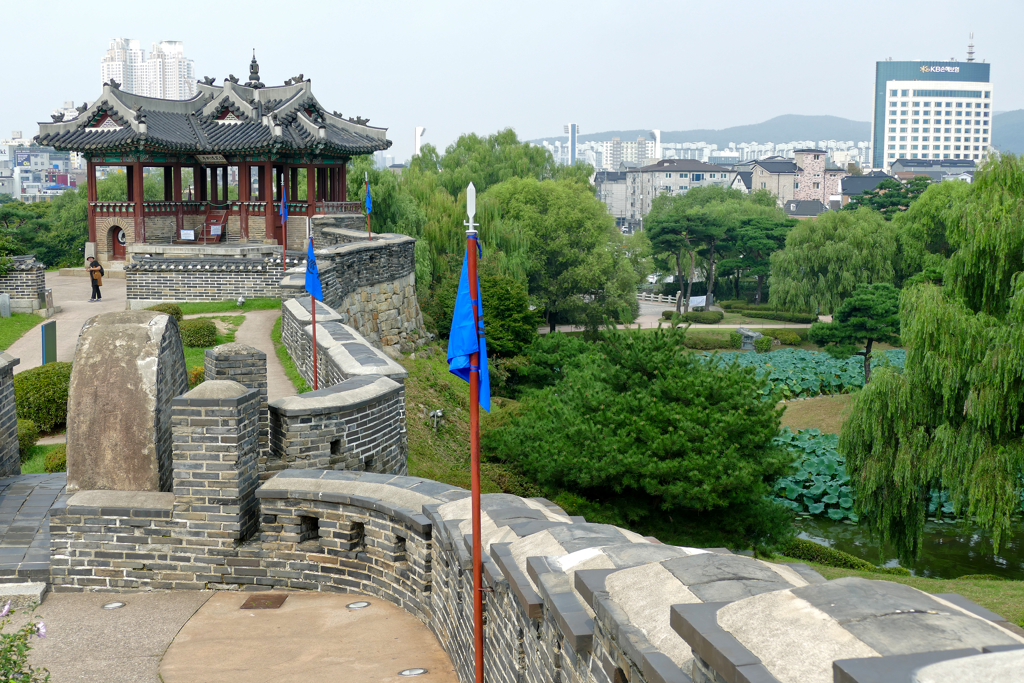
Suwon
Suwon is located less than 50 kilometers south of Seoul. You can easily get there in about one and a half hours by regional public transportation like for instance the subway. Suwon’s most important landmark is the old city wall that surrounds the center for almost six kilometers. King Jeongjo commissioned the construction at the end of the 18th century. During the Japanese colonial era as well as during the Korean War, the fortress was badly damaged. Eventually, it was restored and made it onto the list of UNESCO World Heritage Sites in 1997.
An easy and relaxing walk around the entire wall takes about two hours during which you have fantastic views of Suwon and the scenery beyond on both sides of the path. However, if you get tired or lose interest along the way, you can stop the hike at any time. At intervals, there are stairs leading down from the wall. Given this outstanding activity, I think it’s pretty unlikely that anyone will lose interest. So come on, lace up your shoes, and let’s explore the mystic Hwaseong Fortress Wall.
However, I would refrain from walking those walls on an extremely sunny day as you’ll face totally unprotected exposure. If you cannot avoid visiting on a hot day, make sure to put on sun protection with a very high SPF. Take enough water with you, and wear at least a hat.
Founding Hwaseong
In 1789, King Jeongjo, the 22nd king of the Joseon Dynasty, moved his father’s tomb to the Paldalsan Hill in today’s Suwon. When the future King Jeongjo was 10 years old, his father Crown Prince Sado suffered a horrific death after a political struggle. Due to the death of his older half-brother, he became Crown Prince in 1728, but at the age of 27, his own father King Yeongjo confined him in a rice chest in the summer heat so that he died of thirst and starvation.

Upon ascending the throne, Jeongjo intended to honor and rehabilitate his father by moving the grave to a memorable place. At the same time, he commissioned a new city near the tomb, built a fortress, and moved his residence there. Hwaseong, which was Suwon’s name at that time, was intended to demonstrate economic and military power. Hence, Jeongjo commissioned a royal library and stationed a garrison there as he must have feared possible attacks from his rivals in Seoul.

After the stronghold was completed, a city was created within the fort. It was divided by two intersecting streets into four sections. Eventually, the city’s name was changed to Suwon.

Due to its strategic importance, Suwon was under heavy siege during the Korean War. Consequently, large parts of the city and the fortifications were destroyed. They were rebuilt mainly in the second half of the 1970s.
If you are a fan of K-Dramas, you have possibly seen those mighty structures in one of the Netflix Series Our Beloved Summer, Twenty-Five Twenty-One, Once Again, and Itaewon Class or any of the other shows that were filmed there.
Exemplary And Unique
Korean philosopher and poet Jeong Yak-Yong was also strongly interested in civil engineering. As he impressed King Jeongjo with a pontoon bridge he had designed, the Emperor commissioned him to develop and supervise the construction of the walls for the Hwaseong Fortress. Jeong carefully planned a combination of residential and military features by considering the latest scientific knowledge of that era. Therefore, Hwaseong Fortress had a major impact on the development of Korean architecture, landscaping, and urban planning. To this date, Hwaseong Fortress represents the pinnacle of 18th-century military architecture.
But Hwaseong Fortress is also unique in that it covers both flat and hilly land. Actually, it uses different terrains in its favor for maximum protection. And finally, it was also one of the first Korean construction projects where heavy construction equipment was used.
Hwaseong Fortress Wall
As I came to Suwon from Seoul by subway, I had to take the bus to get to the part of town which is surrounded by the fortress wall. Mind you, Suwon is actually a large city with 1.2 million inhabitants. Samsung Electronics is headquartered in Suwon, after all.
The fortress originally comprised four cardinal gates, floodgates, observation towers, command posts, arrow launcher platforms, and firearms bastions. However, there were also secret gates and bunkers.
As time went by, the fortress wall had to be disrupted in nine spots to accommodate today’s traffic.
I walked the wall from the very southeastern point and ended my excursion in the west at the Daeseungwon Temple. From there, I went down the sloping hill and ended my visit at the Hwaseong Haenggung, hence, the palace where the King and his family fled during wars and times of crisis.
Below, I’m introducing the most beautiful pavilions and other structures I saw during my walk. I hope my brief explanations will help you comprehend the significance of the individual architectural elements so that you can enjoy your own exploration even more.
Mun And Gangnu
The best and most popular spot to begin the walk on the old wall is at the majestic Paldalmun. By the way, this is a wonderful example of the structure of the Korean language: Just like in German, for example, terms in Korean are often composed of two or three individual words. This creates words that seem frighteningly long to foreigners. While this gate is called Paldal Gate in English, in Korean it is contracted into one word, namely Paldalmun.
Howsoever, it is the southern gate of the Hwaseong Fortress. Among the four gates of fortification, the northern and southern gates are splendidly decorated and also bigger as they needed an entrance wide enough for the King’s palanquin. The Paldalmun, as well as the northern Janganmun, are impressive two-storey wooden structures on stone bases. They are flanked by gated platforms and shielded by ravelins built of fired brick.

Just two blocks east of the gate are stairs leading up the defense wall. Once you’re at the top, you simply cannot lose your way: Just follow the path.
The stairs end next to the Dongnamgangnu. Dongnamgangnu simply translates to Southeastern Pavilion. It was built to protect Namsumun, the now-destroyed floodgate. While Dongnam translates to the southwest, a Gangnu is the stone structure the pavilion stands on, hence, an elevated spot from where you can monitor a vast area. During wartime, it was a command post. In peaceful times, however, the Dongnamgangnu was a resting place.

Hwaseong Fortress has a total of four gangnus. Among those pavilions, Dongnamgangnu has the widest angle view inside as well as around the fortress.
Poru And Chi
Dongiporu is the eastern guard pavilion. From here, soldiers guarded the eastern area of the fortress as well as beacon towers called Bongdon in Korean.

The wooden structure of the Poru was built on top of a square turret and completed in 1796. You’ll find five more of these protruding turrets around the fortress walls. Their position made it much easier to repel enemy attacks.
Between each of the eastern Porus and Bongdons stands a Chi, an inwards protruding section that is sheltered by the wall. As they cannot be seen from the outside of the fort, they allow the attack of unsuspecting enemy troops. As a matter of fact, Chi is named after a pheasant with the ability to hide from its enemies by camouflaging.

There is a total of ten of these structures along the wall.
In the northern part of the eastern wall is Changnyongmun, Hwaseong’s eastern gate. Its name refers to the blue dragon of feng shui as it represents the east. The construction in 1795 took actually only five months. The names of those in charge of the completion are carved into a polished granite wall to the gate’s left. Sadly, all the other commemorative plaques have been lost over the years.

In contrast to the Paldalmun and the Janganmun, the wall surrounding Changnyongmun is open to one side. The tower, a one-storey wooden pavilion on a granite base, was destroyed during the Korean War and reconstructed in 1976.
Simdon And Jangdea
Dongbukgongsimdon is the northeastern watchtower which was used by troops to monitor the surrounding area.

After completion in 1796, it was the first of its kind at Hwaseong Fortress. Its round shape makes it a unique feature among the other structures.

Another architectural highlight among the edifices is Dongbukgangnu, the northeastern corner pavilion which also goes by the name of Banghwasuryujeong. It is an L-shaped construction with a sophisticated roof design. The pavilion overlooks a large pond, and the consonance of the building with the lush surroundings makes it one of the most distinguished features of the Hwaseong Fortress.
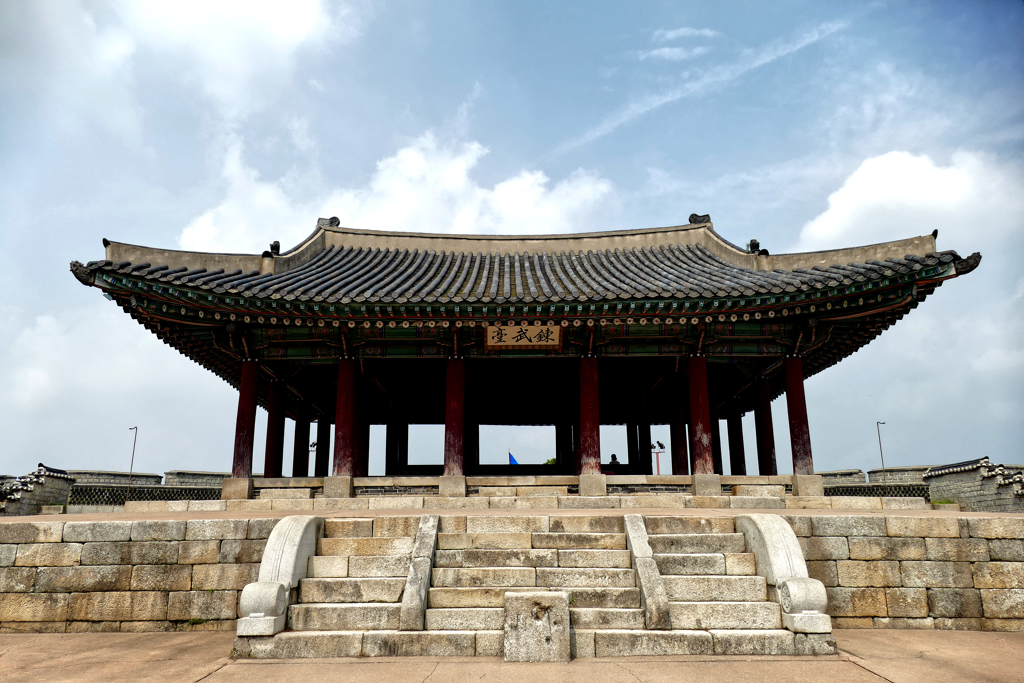
Initially, the pavilion was built as a command center. Here, a commander would direct and train his soldiers. Over time, though, Dongbukgangnu was more used for enjoying the scenery and life: Already at the completion of the Hwaseong Fortress, a large banquet was held in the courtyard in 1796. More than 2,700 people who contributed to this massive construction project celebrated their great historic achievement!
Go West
Another architectural jewel is Hwahongmun, the northern floodgate. It was idyllically built over Suwoncheon, the main river flowing through the Hwaseong Fortress. An alluring pagoda stands on top of seven stone arches. An octagonal stone pillar with a statue of a mythical, dragon-like creature, a so-called Mugi, stands on each end of the bridge.

Over the centuries, floods destroyed the floodgate several times. It had to be reconstructed several times, last in 1932.

As you walk on, the next major construction will be the Janganmun which is the northern and main gate of the fortress. Its tower is one of the biggest in Korea, even larger than the one of the Sungnyemun Gate in Seoul.

In this area, the gate turret Bukseojeokdae is strategically located at the front of the fortress. It increased the protection of the fortress and stopped enemies from approaching the Janganmun Gate. Archers were able to shoot arrows through the narrow vertical embrasures without exposing themselves.

As it was getting late and also because, at this part of the wall, you have to climb the Paldalsan Mountain, I decided to finish my walk at King Jeongjo’s Statue. From there, I walked downhill on a gentle slope. You can also take stairs, but then you miss out on the charming Daeseungwon Temple which would be a shame.
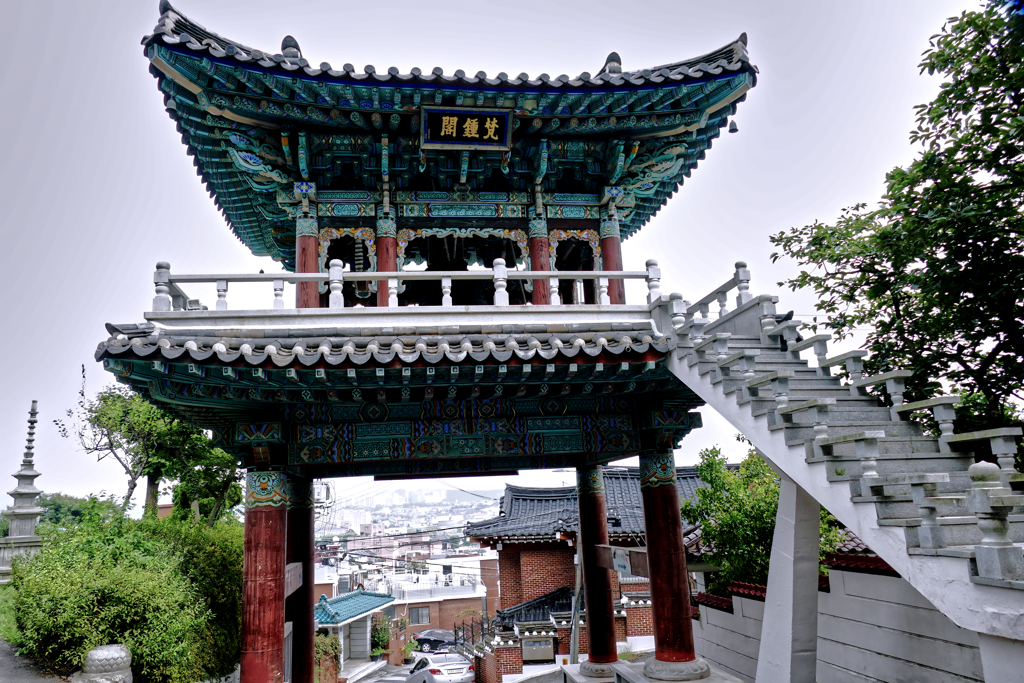
At the end of the slope is Hwaseong Haenggung, the temporary palace, which is a highlight of the visit, obviously.
Hwaseong Fortress Tourist Trolley
As I pointed out above, my walk along the old wall was very enjoyable. However, I must say that I’m an avid and passionate walker. Although the trail is mostly flat and ascends only on the southwestern end, almost six kilometers can be long for those who are not used to walking – or for smaller kids.
The latter will especially enjoy the opportunity to see Hwaseong Fortress from a trolley which is designed after the royal vehicle used by King Gojong and the Palanquins of the Joseon dynasty. The Hwaseong Fortress Tourist Trolley takes its passengers on a comfortable tour to the main attractions of the fortress. As it moves at a gentle speed of only fifteen kilometers per hour, its 44 passengers have enough time to enjoy the views and take pictures. All seats have earphone jacks so you can comfortably listen to the explanations supplied in English, Chinese, and Japanese – apart from Korean, obviously.
The tour takes about an hour and costs KR₩ 4,000 for adults and KR₩ 1,500 per child.
The Hwaseong Fortress Tourist Trolley departs at the Hwaseong Haenggung Palace in the morning at 09.50, 10.40, and 11.40, and in the afternoon at 1.40, 2.40, 3.40, and 4.40. Trips do not take place when it rains or snows.
Hwaseong Haenggung Palace
A so-called Haenggung is a temporary palace, and the one in Suwon is the largest in all of Korea. It was used by the royal family ever since the time of King Jeongjo. Usually, the Emperor and his family found shelter in the palace in times of crisis. Apart from using it for protection, King Jeongjo also stayed there during visits to his father’s tomb.

This is where King Jeongjo held the royal banquet for his mother’s 60th birthday.
The palace was built on the eastern foot of Paldalsan Mountain in 1789. It follows the architectural style of the earlier palaces in Seoul. There are ceremonial halls and a shrine. You’ll find a serene garden, as well as living quarters for the royal family, the concubines, servants, and government officials.

The palace was the glamorous venue of a magnificent extravaganza held on the 60th birthday of King Jeongjo’s mother. But many other festivities were also celebrated here, such as award ceremonies and certificate presentations. Actually, the palace serves as a venue for many traditional cultural performances and activities to this date.

What makes a visit to the palace a bit different is the furnishings. Also, there are some set scenes to give you an idea of what palace life was like.
Hwaseong Haenggung Palace is open for visits from Tuesday to Sunday between 9 a.m. and 6 p.m. The general admission is KR₩ 1,500.
How to Get There
Going from Seoul to Suwon is very easy: Just hop anywhere in the city on the Incheon-bound subway line #1. Then, at Guro station, you’ll have to change to the Suwon-bound subway which happens to be #1, too. This train departs from a different platform, but usually, there are subway officials showing passengers the way. While it’s easy, it can get very long. Keep in mind that depending on where you board the subway, the trip can take up to two hours.

Depending on where in Seoul your day trip starts, it might be more convenient to take one of the buses going to Suwon from Gangnam Station like for instance #3002. Other buses are leaving from Sadang respectively Seoul Station. The big advantage is that a bus might take you right to the heart of the center. The subway station, on the other hand, is a 20-minute bus ride from the Paldalmun.

This being said, the bus system in Suwon is as reliable and cheap as in any other city in South Korea. At the bus stops, you’ll find a list of the respective bus lines, and most major stops and points of interest are listed in English.
Although Suwon is a big city, the touristy places of interest are concentrated more or less in the vicinity of the Hwaseong Fortress Wall and can be easily explored by walking.
Guiding Star App
Either way, using Naver Maps for guidance is basically indispensable when exploring Korea. Therefore, I highly recommend you go to the post Grand Tour of SOUTH KOREA – A Guide for Individual First-Time Visitors. There you can see how to set it up for your particular needs and get some tips on how to make the most of this great App.
Visiting Organized
There are various options to visit Suwon on customized trips from Seoul. You can choose between a half-day tour*, a full-day tour*, and an absolutely amazing evening tour* where you get to see the beautiful structures illuminated by soft golden lights.
Although I’m an avid solo-travelling woman, I sometimes like to join organized tours, especially in a country like Korea where I didn’t have many opportunities to interact with locals or even other travellers.
Therefore, here are some great ideas of what to do when visiting Suwon. Especially during high season, pre-booking online will guarantee your place at the activity of your choice*:
Where to Stay
Most foreign visitors – including myself – are coming to Suwon just on a day trip from Seoul. However, if you want to enjoy the view of the Hwaseong Fortress illuminated after dark, an overnight stay might be just right for you.
There are many hotels in Suwon, and prices range from cheap guest houses to luxurious resorts. A particularly authentic way of spending the night would be at one of the Jjimjilbangs, Korean SPAs. Nope, I’m not kidding you: You can actually spend the night there! Nevertheless, if you want to take this adventure, you should know that you will be sleeping on a sleeping mat in a relaxation room with many other people. Hence, you should definitely have earplugs with you. Other than that: Off to a nighttime adventure!
To learn more about Jjimjilbangs, rush over to my post All You Need to Know Before Visiting a Korean Spa.
If you prefer to stick to more conventional lodging options, you can choose suitable accommodation in Suwon on this map*:
Booking.comMap
On this map, you can trace the old wall and see where all the places I’m introducing in this post are located.
Clicking on the slider symbol at the top left or the full-screen icon at the top right will display the whole map including the legend.
Suwon was only one of three amazing day trips I took during my stay in Seoul. I also paid Korea’s only Chinatown in Incheon a visit and spent lazy hours on Mallipo Beach. However, to read about other great places I’ve seen on my tour around South Korea, go to the main post and take your pick! There, you’ll also find further valuable general information that will make your trip to Korea smoother and much more enjoyable.
Pinnable Pictures
If you choose to pin this post, please use one of these pictures


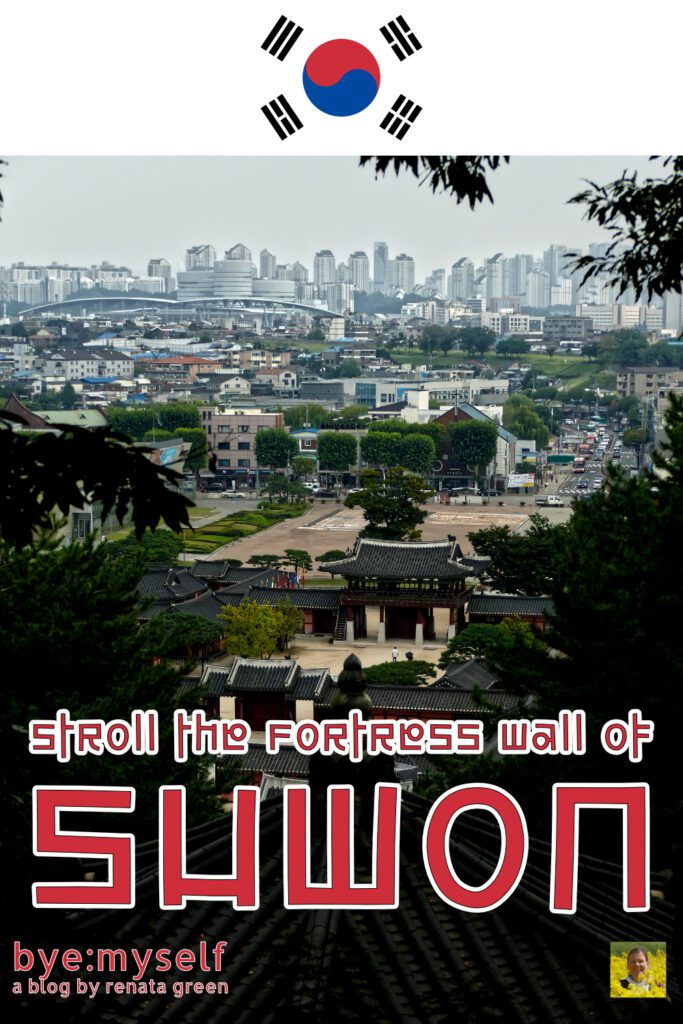
Did You Enjoy This Post? Then You Might Like Also These:
Best Things to Do in SEOUL: The Must-Dos And the Hidden Gems
INCHEON – Best Things to Do in Korea’s Only Chinatown
Green Tea Plantations Around BOSEONG: Totally My Cup Of Tea!
GYEONGJU: Two Days in the City Where Korea’s Imperial History Comes Alive
The Perfect Itinerary for Three Days in BUSAN
7 Best And Most Beautiful Coffee Houses in Busan
How to Experience the Folk Heritage of Korea in ANDONG
Individual Solo Trip to KOREA – All Your Questions Answered
* This is an affiliate link. If you book through this page, not only do you get the best deal. I also get a small commission to run this blog. Thank you so much for supporting me!

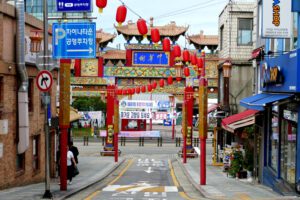


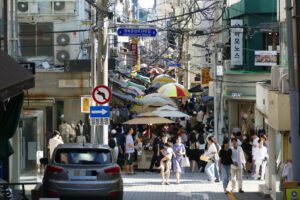



The fortress wall is so impressive. I know nothing about Korean history or architecture so reading this was so interesting. I can’t believe it’s so well maintained given how old it is! It’s good to know how to get there from Seoul, I’d love to visit one day.
It was such a pleasant walk! However, I was lucky to have the perfect weather: Slightly cloudy and not too hot. In the sun, it must be really hard as there is no shade at all.
This is such a neat place to explore. The architecture is so interesting! My daughter’s friend is from Korea and she has wanted to go visit. There are so many cool things to see there.
She should definitely go – with a local, her experience will be on a whole different level!